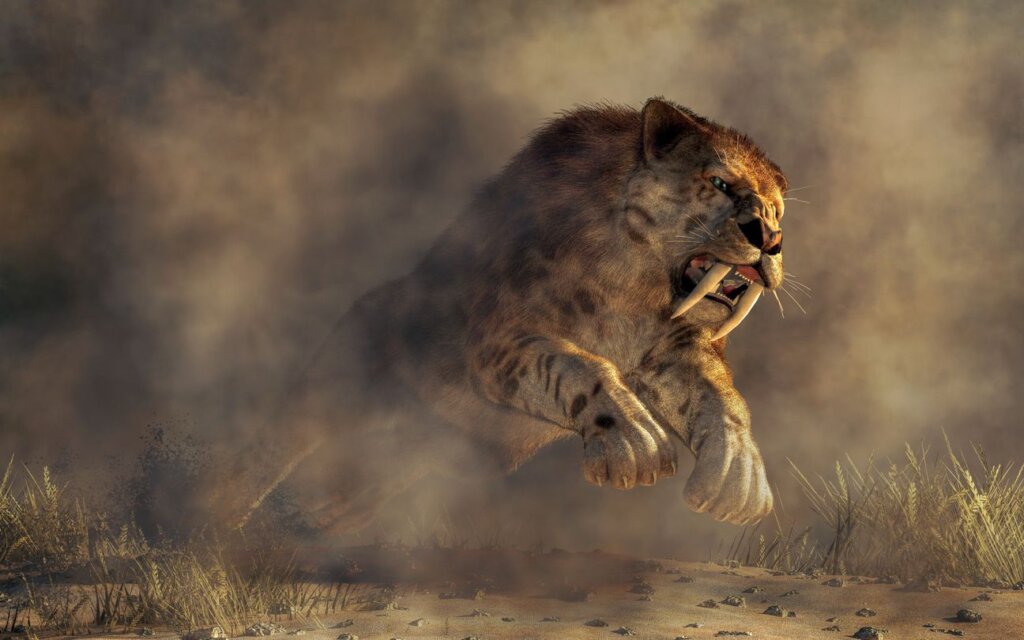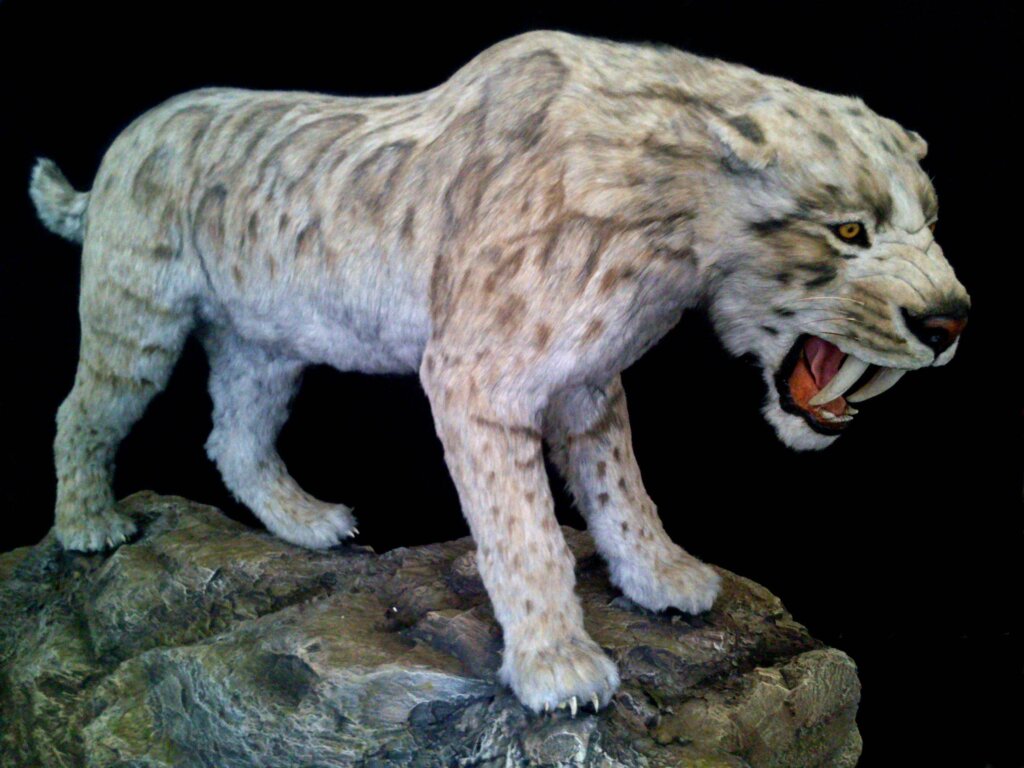5 Curiosities About the Saber-Toothed Tiger

Surely one of the most fascinating animals that has ever existed is the saber-toothed tiger. A ferocious and emblematic felid, but make no mistake, it doesn’t look much like the tigers living today. The most outstanding feature was its long fangs protruding from its mouth. However, there are other remarkable facts that are known about its life. Do you want to know some curiosities about the saber-toothed tiger, also called the Smilodon?
This extinct genus belonged to the subfamily Machairodontinae. It includes 3 species, which are: S. fatalis, S. populator and S. gracilis. Here are some physical aspects of this vertebrate, as well as some amazing facts about its life, do not miss them!
Characteristics of the saber-toothed tiger
Before getting to know some curiosities about the saber-toothed tiger, let’s get to know some facts about its appearance. This animal was similar in appearance to today’s felines, albeit with a more robust build. Its legs were shorter, but wider and more powerful, which suggests that it had great strength in its extremities.
Some elements, such as its short tail and the presence of a short metatarsus, suggest that it wasn’t as fast as other known species.
The body size of the saber-toothed tiger (smilodon) varied, depending on the species, ranging from 55 to 300 kilograms (120 to 660 pounds) in weight. Smilodon gracilis was the smallest, ranging in mass from 55 to 100 kilograms (120 to 220 pounds), and resembling a jaguar. Followed by S. fatalis, from 160 to 280 kilograms (350 to 625 pounds), similar to the Siberian tiger. The largest was S. populator, at 220 to 360 kilograms (485 to 800 pounds). However, it’s believed that some individuals may even have weighed 400kg (800 pounds)
Undoubtedly, the most striking aspect of its physique was its long tusks. These were present in both females and males. In addition, the size and weight of both specimens were similar, so there was no sexual dimorphism. Saber-toothed tigers were about 1.15 meters tall (3.8 feet), while their fangs could reach 18 or even 26 centimeters (7 to 10 inches).
Saber-toothed tiger curiosities
Now let’s look at 5 curious facts about these amazing animals.
1. It had a weak bite
Although it may seem strange, one of the curiosities of the saber-toothed tiger was that its bite wasn’t so strong; in fact it was rather weak, when compared to modern felines. Despite the large size of its fangs, a computer modeling study revealed that the bite power was equivalent to one-third that of a lion (Panthera leo). These results are believed to be related to the way each kills its prey.
2. The hunting method was different from that of the felines we know
The hunting method of the genus Smilodon was different from that of today’s felines. Macaurodontines bit their prey in the neck, after subduing them with their robust body. However, the bite wasn’t intended to suffocate them, but, rather, their fangs were used to sever the trachea and important blood vessels. With this strategy, the victim was left unconscious and died quickly, thanks to deep and lethal wounds.
Some saber-toothed tusks also had serrated edges to facilitate the lethal cut they inflicted on their prey. In this way, time and energy costs were reduced. This method differs from that used by modern feline predators that seek to suffocate their victims, which requires an enormous expenditure of energy for these hunters.
3. They fed on large herbivores
The hunting and killing strategy used by these creatures allowed them to specialize in catching large animals. Among them we can mention bison, mastodons, elk, giant sloths, and even young mammoths.
4. Smilodon have the same common origin as today’s tigers
The popular belief that saber-toothed tigers are the ancestors of today’s tigers and lions is wrong. This is because both groups of animals have a common origin. In particular, approximately 23 million years ago, when the first known felid, called Proailurus, existed. Thus, from this creature of a size comparable to an Iberian lynx, the two lineages of today’s felines and the machairodontinae originated.
5. Extinction occurred approximately 12 thousand years ago

The causes of the extinction of these superpredators aren’t totally clear, but there are two main hypotheses. It is thought that, at that time, the change in the distribution of the large prey that saber-tooths hunted the most was the key to their disappearance.
On the one hand, this may have been due to the fierce environmental changes of the time. And, on the other hand, because of the introduction of the first humans into the environment, who competed as other predators in the ecosystem.
Under these circumstances, Smilodon couldn’t adapt to consume smaller and faster prey, so it ran out of food. Thus, other species that were more flexible and less specialized in their feeding came out of the situation with advantages, such as the lineage of modern felines.
So, we come to the end of our five curiosities about the Smilodon, a fierce predator, of robust build and with large sharp fangs, capable of inflicting deep and lethal wounds in the neck of its prey. As we have seen, this emblematic animal had a very interesting life, and we’ve still got much more to discover about it.
All cited sources were thoroughly reviewed by our team to ensure their quality, reliability, currency, and validity. The bibliography of this article was considered reliable and of academic or scientific accuracy.
- Christiansen, P., & Harris, J. (2005). Body size of Smilodon (Mammalia: Felidae). Journal of Morphology, 266(3), 369–384.
- McHenry, R., Wroe, S., Clausen, P., Moreno, K., & Cunningham, E. (2007). Supermodeled sabercat, predatory behavior in Smilodon fatalis revealed by high-resolution 3D computer simulation. Proceedings of the National Academy of Sciences, 104(41), 16010-16015.
- Reynolds, A. R., Seymour, K. L., & Evans, D. C. (2021). Smilodon fatalis siblings reveal life history in a saber-toothed cat. Science, 24(1), 101916.
- Salesa, M., & Anton, M. (2020). Evolución y desaparición de los félidos dientes de sable. Recuperado el 07 de noviembre de 2022, disponible en: https://www.mncn.csic.es/es/Comunicaci%C3%B3n/evolucion-y-desaparicion-de-los-felidos-dientes-de-sable
